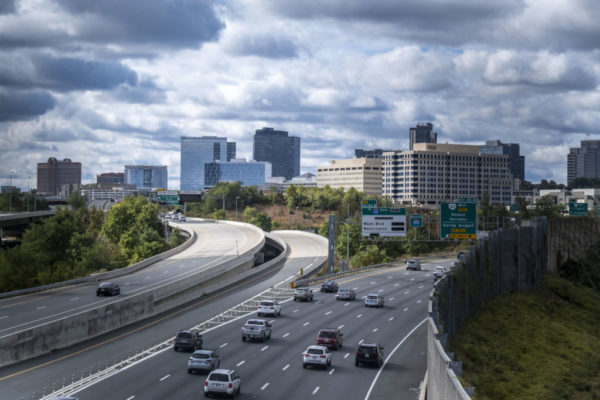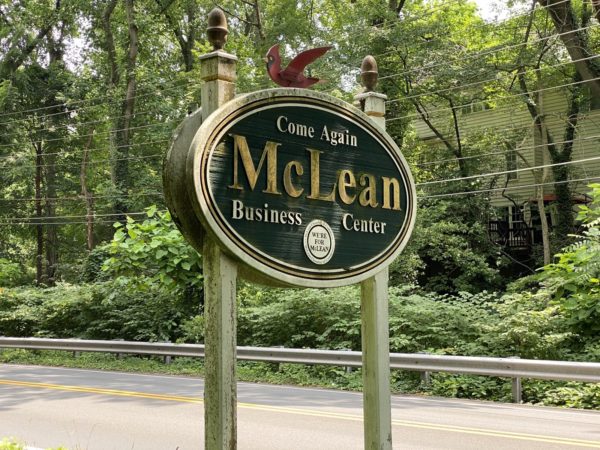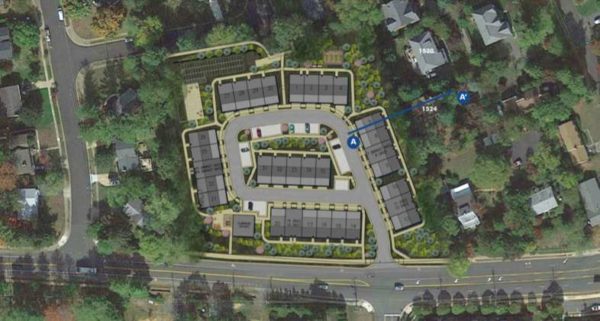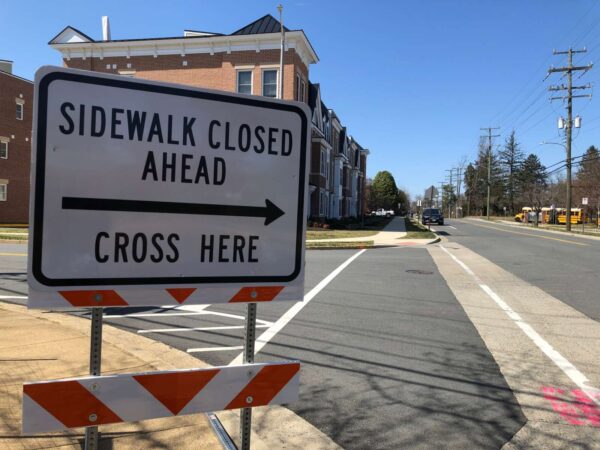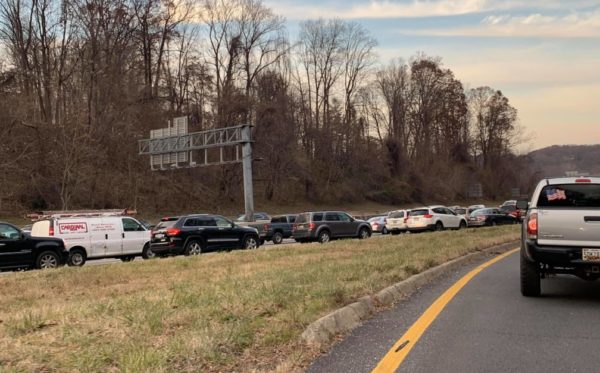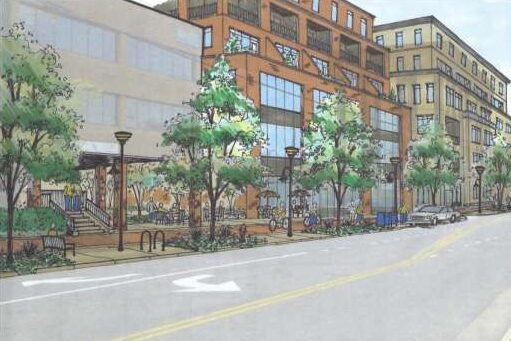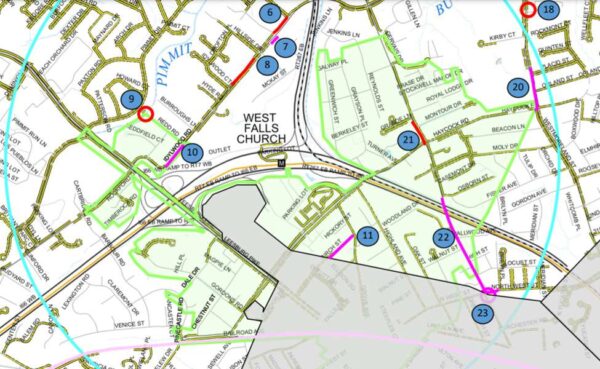
With plans to develop the West Falls Church Metro station area now in place, Fairfax County has decided to evaluate how to improve the surrounding transportation network so it can actually accommodate the anticipated growth.
The Fairfax County Department of Transportation will kick off a West Falls Church Active Transportation Study at 7 p.m. today (Monday) with the first meeting of a new citizens’ advisory group.
The study will focus on the pedestrian and bicycle infrastructure in and around the West Falls Church Transit Station Area, which is bounded by I-66, the Dulles Toll Road, Haycock Road, and the Falls Church City border near Route 7.
“The ultimate goal of the study effort will be to improve pedestrian and bike access and safety around the Metro station,” Dranesville District Supervisor John Foust said by email. “To the extent located in the study area, safe access to several schools, including Lemon Road and Haycock [elementary schools] in the Dranesville District, will also be considered.”
The Fairfax County Board of Supervisors directed staff to create an active transportation plan in July after approving an amendment to the county’s comprehensive plan that allows more mixed-use development in the West Falls Church TSA.
While Virginia Tech halted plans to redevelop its West Falls Church campus earlier this year, the Washington Metropolitan Area Transit Authority officially signed an agreement with developers in August to bring over 1 million square feet of residential, retail, and office space to the TSA.
Coupled with Falls Church City’s impending West Falls project, the development could draw an influx of residents and traffic that has community members pushing the county to address existing safety challenges and enhance streets and sidewalks not built to support the increased density.
The West Falls Church Active Transportation Study will identify possible projects to improve safety, accessibility, comfort, and connectivity for bicyclists, pedestrians, and other non-motorized travelers, according to a draft scope of work.
In addition to providing “multiple opportunities for community input,” county staff will conduct an assessment of existing facility gaps and barriers to access in conjunction with the 13-person advisory group, which will consist of:
- Three representatives each from the Dranesville and Providence districts
- Two representatives each from Dranesville and Providence school PTAs in the study area
- One representative each from the McLean Citizens Association, Providence District Council, Fairfax Alliance for Better Bicycling, and Fairfax Families for Safer Streets
The citizen group will be assisted by a technical advisory group with local and state transportation, schools, parks, and police officials as well as one representative each from Metro, the City of Falls Church, and Virginia Tech.
Noting that the study will encompass both sides of Route 7, Foust points to Haycock Road between Great Falls Street and the Metro station as one area he anticipates will get a lot of attention.
“The sidewalk is very narrow and needs to be improved,” he said. “I also expect [the advisory group] will identify many intersections where we need to improve pedestrian and bicycle safety.”
A tentative timeline for the study has an initial public meeting taking place this winter, followed by the completion of the existing conditions assessment in the late winter or early spring. A final report with recommendations is scheduled to go to the Board of Supervisors in summer 2022.
Foust says the study will establish priorities among the identified projects, which could be funded privately through the county’s rezoning process or compete for public money.
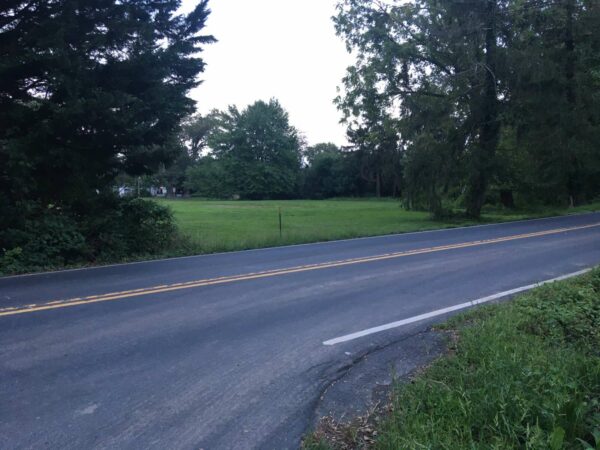
Faced with challenges from providing affordable housing to mitigating flooding, Fairfax County has its hands full, but it’s currently armed with vacant property assessed at tens of millions of dollars.
Currently tax-exempt, the properties could be used for commercial development, environmental preservation, housing projects, recreation, or stormwater drainage, among other purposes.
“There is a critical shortage of affordable housing options in Fairfax County,” Dranesville District Supervisor John Foust said when asked about what the county should do with its vacant properties.
The total financial value of vacant, county-owned properties exceeds $50 million, as calculated based on a public records request and assessments in an online county database for over 100 parcels that could be used for commercial, residential, or other uses.
It wasn’t immediately clear if other restrictions, such as environmental issues, setbacks, and prior plans, limit the use of those properties.
The $50 million-plus figure includes at least $10 million in assessed property that was listed as vacant but nonbuildable, but it excludes properties in floodplains as well as parcels already in use, such as parking lots, parks, or school areas.
One of the largest vacant property acquisitions is across from the Fairfax County Government Center: a 2.6-acre property bordered by Legato Road and Post Forest Drive that cost around $50 million in 1994. It currently has an assessed value of around $11,450.
“One of the elements of the County’s Housing Strategic Plan is to utilize vacant parcels as well as to repurpose land, such as existing parking lots, to increase the supply of housing,” Foust noted by email.
Created in 2018, the Communitywide Housing Strategic Plan calls on Fairfax County to make vacant or underutilized, publicly owned land available for affordable and mixed-income housing “to expand housing options without direct public financial subsidy” through public-private partnerships.
Currently, the Fairfax County Redevelopment and Housing Authority has three such properties that are slated to be developed through public-private partnerships:
- The Oakwood Senior Housing Project, which will provide affordable units for the elderly near Alexandria
- Autumn Willow Senior Housing, a 10.88-acre property near Centreville
- The Route 50/West Ox Affordable Housing Project near Fair Oaks Mall
The county’s more sizable vacant lots include five adjacent properties along South Van Dorn Street in Franconia that occupy around 3.7 acres located near Thomas A. Edison High School.
The county also has a 9.63-acre parcel near the Innovation Center Metro station that will eventually open in Herndon as part of the much-delayed Silver Line extension.
Foust says part of the property includes a community playing field, but its proximity to the Metro station could make it a candidate for future affordable housing.
“Placing affordable housing on the site could be a good use of the land,” he said. “If that came about, the playing field would need to be relocated.”
In McLean, the county has two properties in a residential neighborhood at 7135 and 7139 Old Dominion Drive that have been assessed at a combined $2.06 million. They are slated for a traffic improvement project at the intersection of Old Dominion and Balls Hill Road. The project is currently in the design phase.
Board of Supervisors Chairman Jeff McKay said in a Washington Business Journal story about affordable housing that land is the county’s “single most useful tool.”
“Reallocation of Board-owned property can occur in a number of ways,” McKay said in a statement. “However it is often at the request of a County agency and is followed by an extensive review of the property. Within the last year, the Board was proud to authorize the transfer of two properties to the Fairfax County Redevelopment and Housing Authority for the potential creation of affordable housing.”
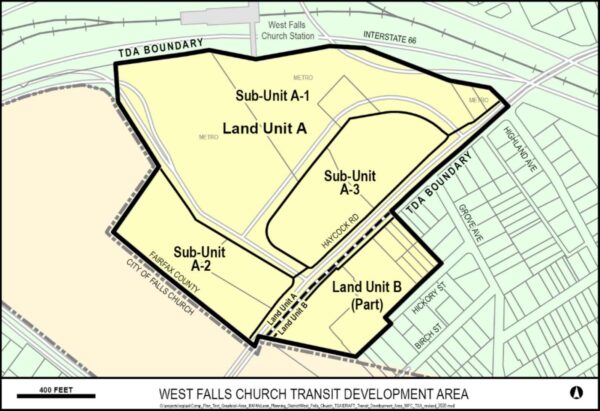
The Fairfax County Board of Supervisors unanimously approved amending the West Falls Church Transit Area Plan on Tuesday (July 13) to clear the road for future development near the Metro station.
The amendment opens up much of the nearby area to mixed-use development, with the aim of creating a residential and retail hub similar to the Mosaic District, but the approval came with some caveats from the county planning commission, and skepticism from some in the public.
Throughout the process, residents in nearby neighborhoods have shared concerns that the new developments will put more traffic onto nearby streets not build to withstand the pressure, particularly putting pedestrians in jeopardy even with some pedestrian improvements planned for the site.
The planning commission made some adjustments to the proposed amendment in recognition of these concerns, such as adding text saying that “connections should be provided within the site and to the existing pedestrian network surrounding the site, with an emphasis on pedestrian safety, accessibility, and comfort.”
At Tuesday’s public hearing, resident Adrienne Whyte said the amendment will allow developers to turn the site into a “gateway to gridlock” and that the suburban character of the nearby streets don’t support the kind of road network envisioned in the site plans.
“What other station depends on a two-lane country road for egress?” Whyte asked.
The project got some support from residents and various advocates, including Sonya Breehey, Northern Virginia coalition manager for the Coalition for Smarter Growth — an organization that Breehey acknowledged is partially funded by project developer EYA.
“The county must prioritize the redesign of its streets to make them safer for people walking and biking,” Breehey said. “Nearby streets need to be redesigned with bike lanes and safer crosswalks.”
Dranesville District Supervisor John Foust, who represents the area, celebrated the approval, but he acknowledged the ongoing community concerns and said he would support improvements down-the-road to nearby streets.
“Our work is not done,” Foust said. “Clearly there is concern…by neighborhoods that have challenges today. With or without this application, we need to address them.”
Board of Supervisors Chairman Jeff McKay said the project was adequately vetted and the area is appropriate for the planned development, but agreed with Foust that the nearby transportation problems can’t be ignored.
“Clearly, near a Metro station like this is where you want to see this type of growth,” McKay said. “That being said, residents have good reason to be concerned. We’ve got work left here to do.”
Virginia’s plan to extend the I-495 Express Lanes to the George Washington Memorial Parkway in McLean, just south of the American Legion Bridge, is now one step closer to becoming a reality after the project received key federal approvals late last week.
The Federal Highway Administration (FWHA) and National Park Service (NPS) both determined that the I-495 Express Lanes Northern Extension (495 NEXT) project would have no significant environmental impact based on an assessment submitted by the Virginia Department of Transportation, which announced the news on Friday (July 9).
FHWA also approved the project’s interchange justification report, which analyzed the potential traffic impacts.
The approvals allow VDOT to move forward with the design and construction process, even as many community members and local elected officials remain skeptical that the project should advance with Maryland’s Capital Beltway expansion plans in limbo.
“This is an essential step toward bringing relief and multimodal solutions to a section of I-495 that faces daily congestion and unreliability,” VDOT Deputy Commissioner Rob Cary said in the news release. “We are appreciative of the collaboration and partnership from our federal partners, as we work together to implement the best possible solutions to improve travel on the Capital Beltway and in our region.”
Signed on June 29, the FWHA Finding of No Significant Impact (FONSI) considered the project’s implications for surrounding communities, land use, historic properties, water and air quality, noise, and other factors.
The report says building the proposed three-mile toll lanes extension “could result in short-term reduced water quality, floodplain impacts, and forest and wetland impacts,” but the impacts could be minimized with “the implementation of state-mandated best management practices and conformance with current stormwater regulations.”
“Overall cumulative effects of the project are not expected to be significant,” FWHA says in the report. “In addition, current regulatory requirements and planning practices help to avoid or minimize the contribution of present and future actions to adverse cumulative effects for socioeconomic, natural, and historic resources.”
According to the NPS FONSI approved on June 7, 495 NEXT would permanently affect 0.9 acres of George Washington Memorial Parkway because land is needed to tie the project into the existing interstate near the American Legion Bridge. 1.3 acres of park land would be temporarily affected during construction, including the clearing of forest canopy and plants.
Still, the park service concluded the impacts will be minimal compared to the anticipated benefits of the project, which VDOT says will reduce traffic congestion, improve trip reliability, and support more travel options, with the addition of a shared-use path from Lewinsville Road to Live Oak Drive and bus service between Virginia and Maryland.
“The Build Alternative will result in both beneficial and/or adverse impacts on the Park,” the NPS said. “However, the NPS has determined that the Build Alternative can be implemented without significant adverse effects.” Read More
A long public process that started with one of Tysons Reporter’s very first stories ended Tuesday night (June 22) when the Fairfax County Board of Supervisors unanimously approved a plan intended to revitalize McLean’s stagnant downtown.
The Community Business Center plan breaks McLean into certain areas where greater density will be allowed in exchange for certain public amenities, with the density gradually decreasing from that new epicenter out towards the existing neighborhoods.
The passage wasn’t without controversy, with prominent community groups like the McLean Citizens Association (MCA) continuing to oppose the plan.
“The MCA opposes the new comprehensive plan because of certain major deficiencies,” MCA representative Scott Spitzer said at Tuesday’s public hearing.
The MCA’s opposition to the plan focused on a few particular issues, like concerns about losing surface parking in favor of a push toward underground or on-street parking. The MCA also sought to have more language in the plan that would guarantee certain above-roof features.
Other speakers at the meeting were more general in their opposition.
“The Mclean CBC vision plan being discussed here today is awful,” said Dennis Findley, a McLean resident and an architect. “It’s just awful…It’s developer-incentivized talking points. It’s a nightmare dystopian vision for my beloved community.”
There was some back-and-forth between Dranesville District Supervisor John Foust and Paul Kohlenberger, president of the Greater McLean Chamber of Commerce. Kohlenberger said his opposition to the plan as drafted was shared by every other McLean community-wide organization, though Foust later pushed back against that claim.
“We, like the others, have broadly supported the plan amendment process and support the aims of the process, and so does the broader community, but significant changes have been made since the task force stopped meeting in December,” Kohlenberger said. “Significant changes have undermined the plans ability to deliver the key benefits: multimodal connectivity, central gathering spaces, housing diversity, and stormwater management.”
In a tense exchange, Foust accused Kohlenberger of misrepresenting the views of other community organizations, stating that different groups have expressed different, sometimes incompatible demands.
“Everything you want is exactly what the organizations that have testified up to this point have said they don’t want,” Foust said. “You are on the outer limits…This is the reason it was so hard to get consensus.”
Other local residents expressed a concern that the McLean CBC plan would turn McLean into a new Tysons, saying they wanted to preserve the community’s “suburban character.”
Foust disputed that fear, saying that the proposed plan will provide more incentive for redevelopment in McLean than the existing comprehensive plan, which currently doesn’t allow enough development to justify the associated costs, but not to the extent allowed in Tysons.
“For many years, I’ve heard from residents who want a more pedestrian-friendly, vibrant downtown where we can celebrate a sense of place, where McLean residents can gather and celebrate community-focused events,” Foust said. “…We are not creating another Tysons. I believe this plan addresses each of the concerns and accommodates the goals set forth by the community.”
Ultimately, Foust led the Board in approval of the project.
“There’s strong interest in both directions,” Foust said. “We tried to find a middle and I think we did. There’s lots of misinformation out there…I think we have an excellent plan. It’s what the community wants, and not necessarily what certain organizations and individuals want. [But] doing nothing in McLean is not an option. Either we revitalize the business district or we continue to deteriorate and provide fewer and fewer community amenities. We see it year after year.”
The rest of the Board of Supervisors asked no questions and made no further comment on the plan. Chair Jeff McKay said he shared Foust’s sentiments regarding the necessity of the plan for McLean’s future.
“Often times we want the amenities, but folks don’t want any impacts, and ultimately we know that’s not possible,” McKay said. “So, we have to craft a plan that tries to balance the issues of revitalization with some real concerns from the community and when you do that, there’s often disagreement over how far one went at the expense of the other. The idea of doing nothing isn’t really acceptable.”
McLean has had its fair share of contentious development debates, but to the relief of everyone involved, a planned senior living facility at 1638 and 1642 Chain Bridge Road didn’t go that way, instead getting a unanimous vote of support from the Fairfax County Board of Supervisors.
Tension over the future of development in McLean has been brewing in recent weeks with the much-debated downtown revitalization plan headed for a delayed planning commission public hearing on May 26.
In this case, however, Dranesville District Supervisor John Foust says the cooperation and willingness to compromise from both developer Tri-State Development Companies and the nearby residents resulted in a smooth process.
The plan is to build 35 independent living units, five of which are expected to be sold as affordable, and a central clubhouse area for residents to gather.
“This has been a really good experience, working with the community and this developer,” Foust said. “Sometimes you don’t come away with such a good taste in your mouth after you go through a difficult land use case, and this wasn’t simple, but everyone was so positive and cooperative and I want to thank everyone involved in the process.”
While speakers at the meeting generally expressed support for the project, neighboring property owner Bobbi Bowman, who said she’d lived there for 22 years, stated that she still had concerns about the noise level from the clubhouse on the site.
“I will look over my back yard and side-yard fences into the front yard of two-story townhouses and clubhouse with an joining outdoor area,” Bowman said. “I believe this application fails to meet county standard that says such development must be compatible…I am not asking the applicant to forego the clubhouse, I’m only asking to be protected from the noise.”
Tri-State has agreed that the clubhouse will not be rented out to anyone outside of the condominium owners association that will be formed to govern the facility, and no audible music will be allowed in the patio area, according to a list of approved development conditions attached to the project.
Other speakers said they were looking forward to the development in part because they see the need for senior housing for their parents or for themselves a few years down the road.
“I think it’s an excellent idea,” nearby resident Eric West said. “I don’t know of any place within the DMV that has something that would meet the needs of those who want to age in place.”
Winnie Pizzano, president of the nearby Stoneleigh Homeowners Association, said the project had great support from within her community.
Resident Scott Shawkey expressed hope that the project could help pave the way for a transformation of McLean’s downtown area, a goal of the county that has been several years in the making.
“I have a father in his 80s who’s worked his entire life for something nice,” Shawkey said. “This is something special, a celebration of life. I think it will be great…We have an incredible community, but our downtown is just a four-way intersection.”
Map via Fairfax County
FBI Agent Fired Weapon During CIA Security Incident — “Law enforcement sources tell ABC News that at least one FBI agent opened fire on a suspect outside CIA headquarters in McLean, Virginia Monday. The suspect has been transported to a local hospital. His condition is unknown.” [ABC7 News-WJLA]
Vienna Holds Town Council Election — Today is Election Day in the Town of Vienna. Residents can vote in person from 6 a.m. to 7 p.m. at the Vienna Community Center. Four candidates are on the ballot seeking to fill three town council seats. [Town of Vienna/Twitter]
Dranesville Supervisor Surprised by New Police Chief’s History — Supervisor John W. Foust says he was not aware of new Fairfax County Police Chief Kevin Davis’s involvement in two past use-of-force incidents before they were reported by NBC4. He calls the alleged misconduct “very disturbing” and says it should’ve been disclosed to the board. [The Connection]
Region Urges COVID-19 Vaccinations with Media Campaign — Northern Virginia’s health districts, including the Fairfax Health District, launched a new media campaign on Friday “to encourage everyone in the region to get vaccinated. The campaign encourages broad vaccination across the region while also focusing on various audiences who remain vaccine hesitant.” [Fairfax County Health Department]
Local Residents Lobby for Leaf Blower Ban — A new citizens group called Quiet Clean NOVA is calling on Virginia lawmakers to prohibit the use of gas-powered leaf blowers, critiquing the noise and air pollution they produce. Del. Kaye Kory, whose district includes southern Falls Church into Annandale, says she will introduce legislation this fall that encourages the use of quieter electric and battery-powered blowers. [ABC7 News-WJLA]
(Updated at 2:10 p.m.) Officially, the Fairfax County Board of Supervisors endorsed the I-495 extension of the express lanes on Tuesday (April 13), but the discussion leading up to that vote showed that some officials closest to the project still have reservations.
Supervisor John Foust, representing the Dranesville District that would ostensibly stand the most to gain from the project called 495 NEXT, said the project only addresses half the problem and, without the other half, could only worsen an already miserable bottleneck.
“I’ve lived with the horrible congestion caused by backups at the American Legion Bridge and I’ve supported widening or replacement of the bridge,” Foust said. “But without the Maryland project, 495 NEXT worsens traffic in the general portion lanes…Until the American Legion Bridge is widened, these adverse impacts are far greater than any public benefit.”
The plan would add new express lanes from 495’s intersection with the Dulles Toll Road up to the American Legion Bridge, where the plan was to connect with similar lanes on the Maryland-owned bridge and onto the Maryland side of the beltway. Foust’s frustration comes from Maryland dragging its heels on the project despite an earlier pledged commitment to widening.
Foust said that, as recently as December, the Board agreed that VDOT should only consider further action on widening once Maryland executed a comprehensive agreement with a developer to fulfill their half of the project.
“Of course that hasn’t happened, nothing significant has happened since December to justify us reversing our opinion,” Foust said. “I want to make it clear, I think it’s a mistake. Going forward without agreement from Maryland is exposing us to worsening impacts.”
But Fairfax County has faced mounting pressure to endorse 495 NEXT, most recently from Virginia Secretary of Transportation Shannon Valentine. Board of Supervisors Chairman Jeff McKay and others on the board described the endorsement as a good-faith move on Fairfax’s part.
“We don’t entirely control the schedule here,” McKay said. “There are some signfiicant benefits to this project. Everyone is familiar with the gridlock that Foust has explained…We’re close to a guarantee that Maryland is making significant progress.”
“This is a chance for Fairfax County to be a leader,” Supervisor Pat Herrity agreed, “and I think this encourages Maryland to move forward.”
The endorsement passed in a 8 to 2 vote, with Foust and Hunter Mill District Supervisor Walter Alcorn voting against it. The new lanes are scheduled to open to traffic in 2024.
Updated 4:50 p.m. to correctly attribute a quote to Martin Smith.
The McLean Citizens Association wants to see significant changes to the downtown revitalization plan slated to go before the Fairfax County Planning Commission this month.
Members of this board focused their criticisms of Fairfax County’s most recent draft plan to update the McLean Community Business Center on parking, building height, overall density, stormwater management, and schools.
The MCA passed a resolution on April 7 opposing the document unless the county made a number of changes, including:
- Reduce language encouraging underground and on-street parking in favor of language protecting surface parking
- Guarantee that a developer’s proposed building height includes all above-roof features
- Require a 10-year review midway through the plan’s proposed 20-year vision with regard to increasing density
- Eliminate language that encourages “innovative solutions” to school overcrowding if, as density increases, schools need to expand
Multiple board members said the resolution contains emphatic language in the wake of the Fairfax County Zoning Ordinance Modernization project. That initiative encountered vocal opposition from many homeowners’ groups, including MCA, but was ultimately approved 7-3 by the Fairfax County Board of Supervisors.
“We took a softer, more positive approach on zMOD and I’m not sure it got us anywhere with zMOD,” MCA board member Jen Jones said. “I think this is just as important as that was, and I think taking a stronger stance makes a lot of sense.”
Martin Smith, who opposes the McLean CBC plan completely, likewise voiced support for the resolution but said he wished the language were even stronger.
“I support this because I think it’s clear that we don’t like the fact that they haven’t responded to our previous suggestions, and I just think we have to make a stronger statement,” he said.
But some members said the resolution contained language that was too strong.
“I think that this is a document which we agree with on very many points,” board member Ron Bleeker said. “There have been some very good points which have been raised and should be considered. Whether this requires us to say we oppose the entire document, I think may not be the best approach.”
Fairfax County staff recently revised its drafted plan to revitalize downtown McLean in response to a wave of public feedback.
Dranesville District Supervisor John Foust and Fairfax County staff say they plan to further engage with the MCA.
“The provisions of the proposed comprehensive plan are very good, but we have time to make them even better before the plan is presented to the Board of Supervisors for approval,” Foust said. “The MCA’s resolution is helpful, and each of their recommendations will be considered as the language of the draft plan is finalized.”
Leanna O’Donnell, planning division director of the Fairfax County Department of Planning and Development, said her department is reviewing the resolution and will be reaching out to discuss the MCA’s concerns.
The draft will go before the Planning Commission on April 28 and the Board of Supervisors on May 18.
Photo via Fairfax County
Some big changes are coming to McLean, and Dranesville Supervisor John Foust says he supports many — but not all — of them.
During a “Good Morning, McLean” breakfast hosted by the Greater McLean Chamber of Commerce yesterday morning (Thursday), Foust highlighted ongoing redevelopment work to the downtown area and Chain Bridge Road, but expressed caution about proposed zoning changes.
He repeated his support for the McLean Commercial Business Center revitalization plan despite some vocal opposition, saying it encourages development while protecting those who do not want McLean to become the next Tysons. The Fairfax County Planning Commission will hold a public hearing on the plan on April 28, and it will go before the Board of Supervisors on May 18.
Foust also spoke favorably about Tri-State Development’s proposal to build a 35-unit senior living facility with townhouses on a Chain Bridge Road site that would otherwise fit nine single-family homes. Earlier this month, the planning commission deferred a decision on the plan until next Wednesday (March 17).
“It’s exactly what McLean residents are looking for who want to downsize but don’t want to leave McLean,” Foust said. “Fundamentally, it’s a good application, and I think it’ll probably get approved.”
The project has received some pushback from nearby residents who say the project extends the business district into their residential area and will cause transportation and parking problems.
Foust acknowledged these complaints, adding that a dedicated left turn lane at the Chain Bridge and Davidson Road intersection could be needed to account for car and foot traffic. Ultimately, though, he believes it is better than the alternative for developers.
“Building nine houses would’ve been miserable,” he said.
McLean is also bracing for the potential impact of Fairfax County’s Zoning Ordinance Modernization project. Most of the changes proposed by county staff are “non-controversial” and will simplify frustrating ordinances, Foust said.
But he opposes a few elements that have also consternated the public, including proposed regulations on flags and changes to the permits required to operate a business from home.
Foust says loosening customer and signage rules for home-based businesses could lead to more businesses in residential areas.
“Staff prepared, I think, a very liberalized version,” he said. “I’m not excited about the direction staff is trying to take this.”
Outside of development and zoning issues, Foust says that, as chair of the Board of Supervisors’ economic initiatives committee, he has been focused on how Fairfax County will recover from the COVID-19 pandemic once it’s over.
The committee will receive a presentation on Tuesday from a consultant that the county hired last year to develop recommendations for its road to recovery. Right now, about $15 million are earmarked for implementing recovery programs, but Foust predicts “that number will increase dramatically” when Fairfax County receives federal funding through the American Rescue Plan Act.
According to Fairfax County, that sum could be $222.56 million, although the exact amount has not yet been confirmed by the federal government.
In the meantime, the vaccine process is picking up, even with more than 103,000 people currently on Fairfax County’s waitlist.
“We’re getting through it,” Foust said. “…I get so frustrated sometimes with the failures we’ve encountered, the bumps in the road, but when I step back and look at what staff and others are accomplishing, it’s just amazing.”
Staff photo by Jay Westcott


